Physical Address
304 North Cardinal St.
Dorchester Center, MA 02124
Ultrasound allows for accurate prediction of gestational age.
The appropriate training and skills are necessary for safely performing and accurately interpreting obstetric ultrasound
There are many options for screening pregnant women, most of which include ultrasound.
Routine obstetric ultrasound has specific recommended views that allow for depiction of many, but not all, fetal anomalies.
Three-dimensional ultrasound, fetal Doppler examinations, and fetal magnetic resonance imaging may be used when additional information is needed beyond that available with routine gray-scale ultrasound.
There were more than 3.9 million live births in the United States in 2013. Ultrasound is the most frequently used imaging modality for assessment of pregnancy. With care being taken to keep exposure to ultrasound limited to medically needed information, and with imaging performed at the appropriate power settings, ultrasound is safe for use in pregnancy.
Indications for ultrasound during the first trimester include pregnancy dating, assessment of women with bleeding or pain, and assessment of nuchal translucency in screening for aneuploidy. In the second trimester, ultrasound is used for pregnancy dating, assessment of interval growth, assessment of patients with abnormal pain or bleeding, assessment of size-to-dates discrepancy, routine survey of fetal anatomy, and assessment of maternal complications due to conditions such as age, drug use, or history of previous abnormalities.
In cases of multiple gestations, ultrasound is used to assess growth and complications of twinning. In women with history of cervical incompetence, ultrasound is used to screen for cervical changes that put a patient at risk for preterm delivery. In the third trimester, ultrasound is predominantly used to assess fetal growth and well-being. Ultrasound is increasingly used for fetal procedures such as testing for aneuploidy, drainage of abnormal fetal fluid collections, and guidance for fetal surgery. Ultrasound is well recognized as the screening modality of choice, but additional information may be needed beyond that available with ultrasound. In many of these cases, especially those with fetal central nervous system abnormalities, fetal magnetic resonance imaging (MRI) can help clarify the diagnosis.
Part IV of this textbook focuses on obstetric ultrasound and reviews specific fetal organ system anatomy and pathology, with chapters also on safety of ultrasound in pregnancy, assessment of twins, and growth. Fetal magnetic resonance (MR) and three-dimensional (3D) ultrasound images are added throughout to illustrate the benefit of these techniques in select cases.
Obstetric ultrasound diagnosis is critically dependent on examiner training and experience. Physicians and sonographers performing obstetric ultrasound examinations should have completed appropriate training and should be appropriately credentialed and/or boarded. Accreditation of ultrasound laboratories improves compliance with published minimum standards and guidelines. Ultrasound practitioners should be knowledgeable regarding the basic physical principles of ultrasound, equipment, record-keeping requirements, indications, and safety of using ultrasound in pregnancy. Studies should be conducted with real-time scanners using a transabdominal and/or transvaginal approach, depending on the gestational age and the region of interest. The choice of transducer frequency is a trade-off between beam penetration and resolution. In general, a 3- to 5-MHz transducer frequency provides sufficient resolution with adequate depth penetration in all but the extremely obese patient. During early pregnancy, a 4- to 7-MHz abdominal transducer or a 5- to 10-MHz vaginal transducer can provide superior resolution while still allowing adequate penetration. Higher-frequency transducers are most useful in achieving high-resolution scans of anatomy close to the probe, and lower-frequency transducers are useful when increased penetration of the sound beam is necessary and when a wider field of view is needed. Use of Doppler ultrasound and 3D imaging depends on the specific indication. As in all imaging studies, complete documentation of the images and a formal written interpretation are essential for quality assurance, accreditation, and medicolegal issues.
Confirmation of the presence of an intrauterine pregnancy
Suspected ectopic pregnancy
Vaginal bleeding
Pelvic pain
Estimation of gestational age
Diagnosis or evaluation of multiple gestations
Confirmation of cardiac activity
Adjunct to chorionic villus sampling, embryo transfer, and localization, and removal of an intrauterine device
Assessment for certain fetal anomalies, such as anencephaly, in high-risk patients
Measurement of nuchal translucency when part of a screening program for fetal aneuploidy
Suspected ectopic pregnancy
Suspected hydatidiform mole
Maternal pelvic masses and/or uterine abnormalities
Estimation of gestational (menstrual) age
Evaluation of fetal growth
Evaluation of fetal anatomy and fetal well-being
Vaginal bleeding
Abdominal or pelvic pain
Cervical insufficiency
Determination of fetal presentation
Suspected multiple gestation
Adjunct to amniocentesis or other procedure
Evaluation of discrepancy between uterine size (as measured by fundal height) and clinical dates
Pelvic mass
Suspected hydatidiform mole
Adjunct to cervical cerclage placement
Suspected ectopic pregnancy
Suspected fetal death
Suspected uterine abnormality
Suspected amniotic fluid abnormalities
Suspected placental abruption
Adjunct to external cephalic version
Premature rupture of membranes and/or premature labor
Previous abnormal screening exams
Follow-up evaluation of placental location for suspected placenta previa or accreta
Previous congenital anomaly
Screening for or follow-up of fetal anomalies
The current guidelines of the American College of Radiology (ACR) and American Institute of Ultrasound in Medicine (AIUM) for the performance of first-trimester obstetric ultrasound examination include documentation of the location of the pregnancy (intrauterine vs. extrauterine), documentation of the appearance of the maternal uterus and ovaries ( Fig. 28.1 ), and assessment of gestational age, either by measurement of mean sac diameter (before visualization of embryonic pole; Fig. 28.2 ) or by embryonic/fetal pole crown-rump length ( Fig. 28.3 ). Another important structure to assess is the yolk sac. An image of the heart rate is taken using M-mode ultrasound. It is important to use M-mode rather than spectral Doppler ultrasound on the embryo to limit power deposition. Late in the first trimester, dating can be performed with measurement of the biparietal diameter and head circumference rather than crown-rump length.
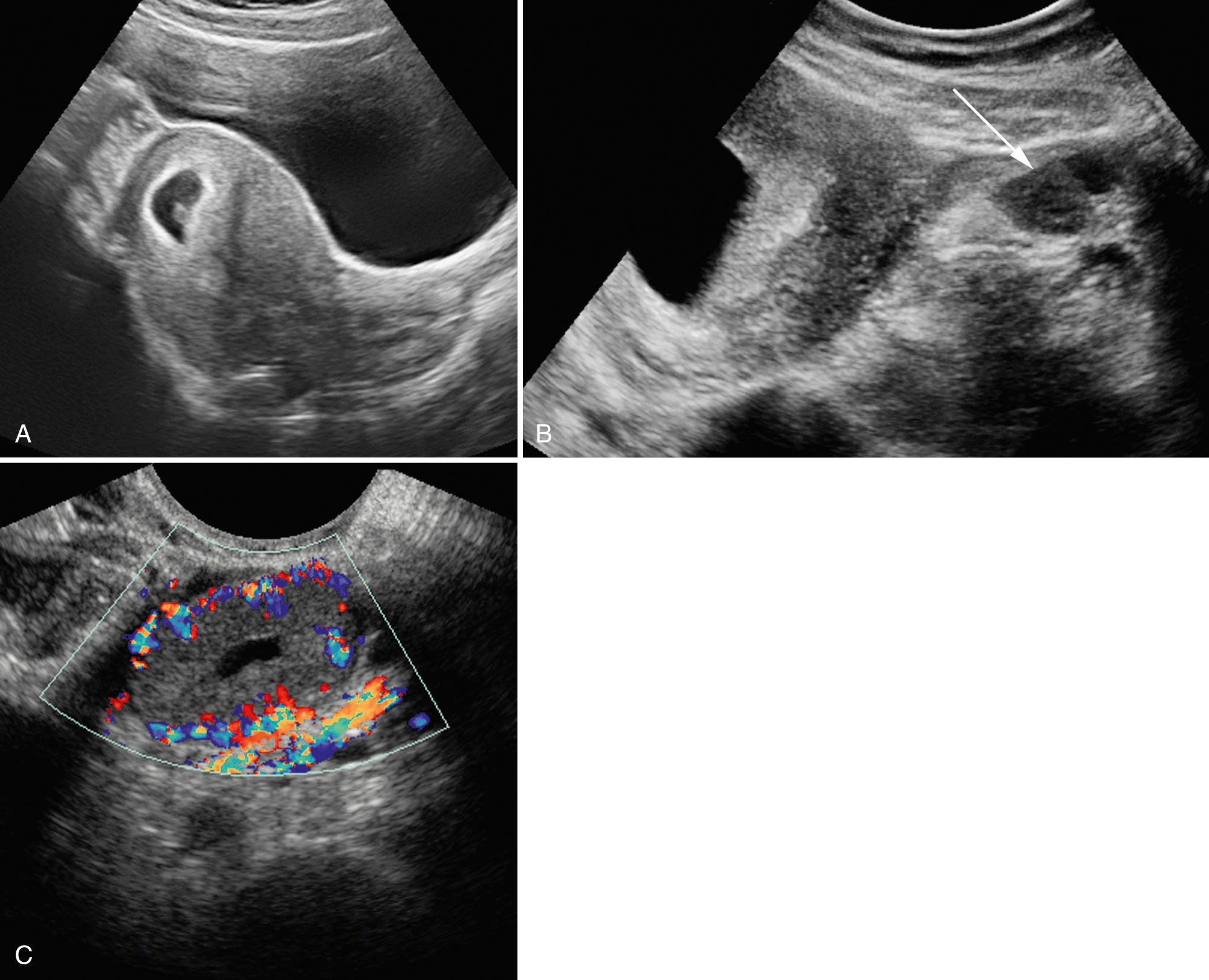
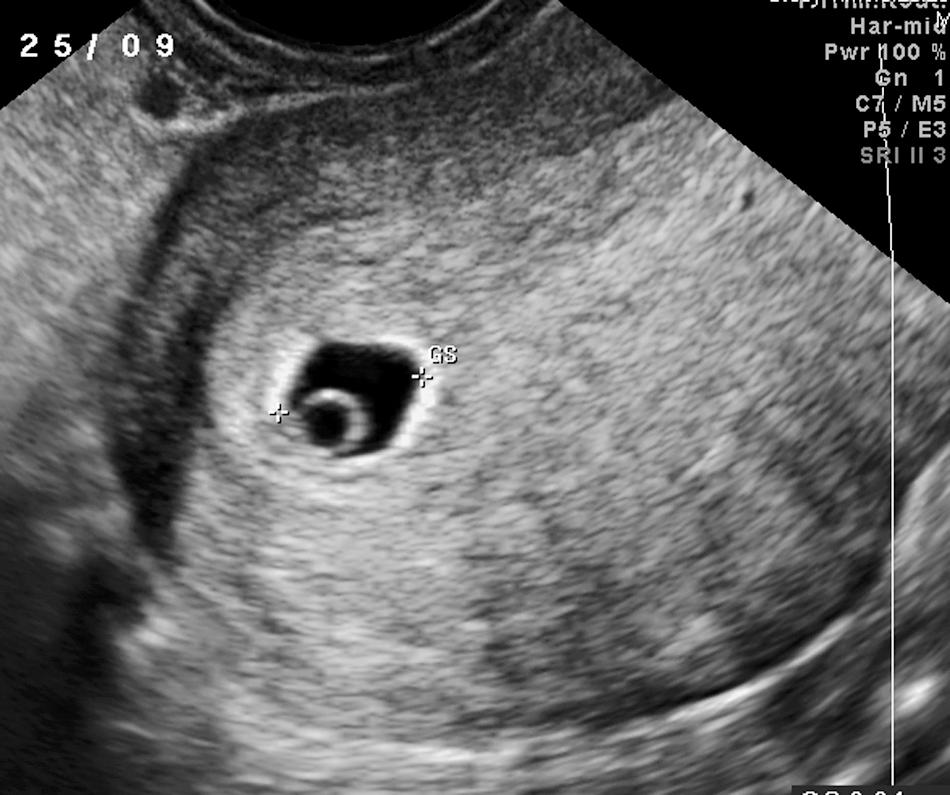
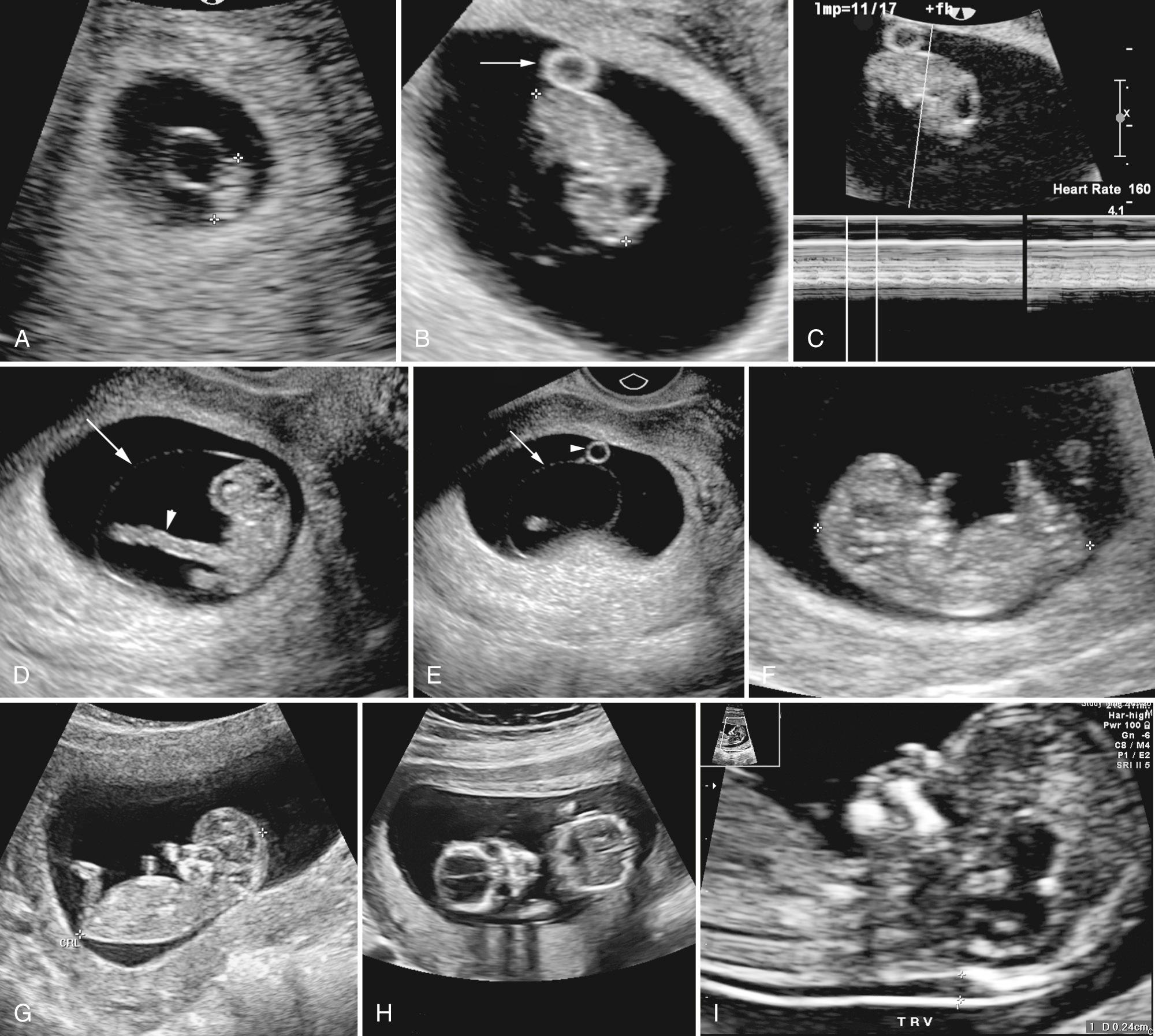
Videos 28.1 and show normal first-trimester findings of an early embryo with cardiac activity (Video 28.1 ) and normal findings of rhombencephalon (Video 28.2 ).
Gestational sac
Location of pregnancy: intrauterine vs. extrauterine
Gestational age (as appropriate)
Mean sac diameter
Embryonic pole length or crown rump length
Yolk sac
Cardiac activity on M-mode ultrasound
Embryo/fetal number (amnionicity/chorionicity)
Maternal anatomy: uterus and adnexa
In the first trimester it is important to not only establish the location of the pregnancy (intrauterine versus extrauteruine) but when intrauterine, to carefully determine if it is a potentially viable pregnancy or if it is a nonviable pregnancy. Due to the variety of medical professionals performing and interpreting ultrasound in a variety of clinical settings, thresholds for the diagnosis of a failed pregnancy have been increased in order to not misdiagnose a potentially viable pregnancy. These issues are discussed in detail in Chapter 30 .
In cases of multiple gestation, first-trimester scans should document the fetal number as well as the amnionicity and chorionicity ( Fig. 28.4 ). Chapter 32 discusses the assessment of multifetal pregnancies.

In addition, the American College of Obstetricians and Gynecologists (ACOG) recommends that prenatal testing for aneuploidy be offered to all pregnant women. Clinicians must understand current screening options (and the tradeoffs between them), including traditional serum analysis (with or without nuchal translucency ultrasonography) or cell-free DNA so that they can discuss these options appropriately with the patient. Cell-free DNA testing uses DNA from the placenta to assess the risk of the fetus having a chromosomal abnormality; it does not assess risk for fetal anomalies such as neural tube defects or ventral wall defects. Management decisions, including termination of the pregnancy, should not be based on the results of the cell-free DNA screening alone. Patients should be counseled that a negative cell-free DNA test result does not ensure an unaffected pregnancy. According to a 2015 ACOG committee opinion, “Given the performance of conventional screening methods, the limitations of cell-free DNA screening performance, and the limited data on cost-effectiveness in the low-risk obstetric population, conventional screening methods remain the most appropriate choice for first-line screening for most women in the general obstetric population.”
Thus despite increased use of cell-free DNA testing, ultrasound screening is still being performed by measuring nuchal translucency between 11 and 14 weeks of gestation (see Fig. 28.3I ). This measurement, in conjunction with maternal age and serology, can be used to determine an individualized risk of fetal aneuploidy (see Chapter 31 ). Increased use of maternal serum screening, as well as first- and second-trimester ultrasound have reduced the number of interventional procedures to detect aneuploidy while increasing the number of prenatal diagnoses of aneuploidy. Given the increased scanning late in the first trimester, it is also increasingly common for a limited anatomic survey to be conducted in the late first trimester. Anomalies that should be detected this early include anencephaly ( Fig. 28.5 ) and omphalocele ( Fig. 28.6 ). Although substantial information can be obtained at this time, the first-trimester anatomic survey is unlikely to replace the second-trimester anatomic survey, since many structures are difficult to visualize completely early in the second trimester, particularly the heart, cardiac outflow tracts, posterior fossa, and distal spine.
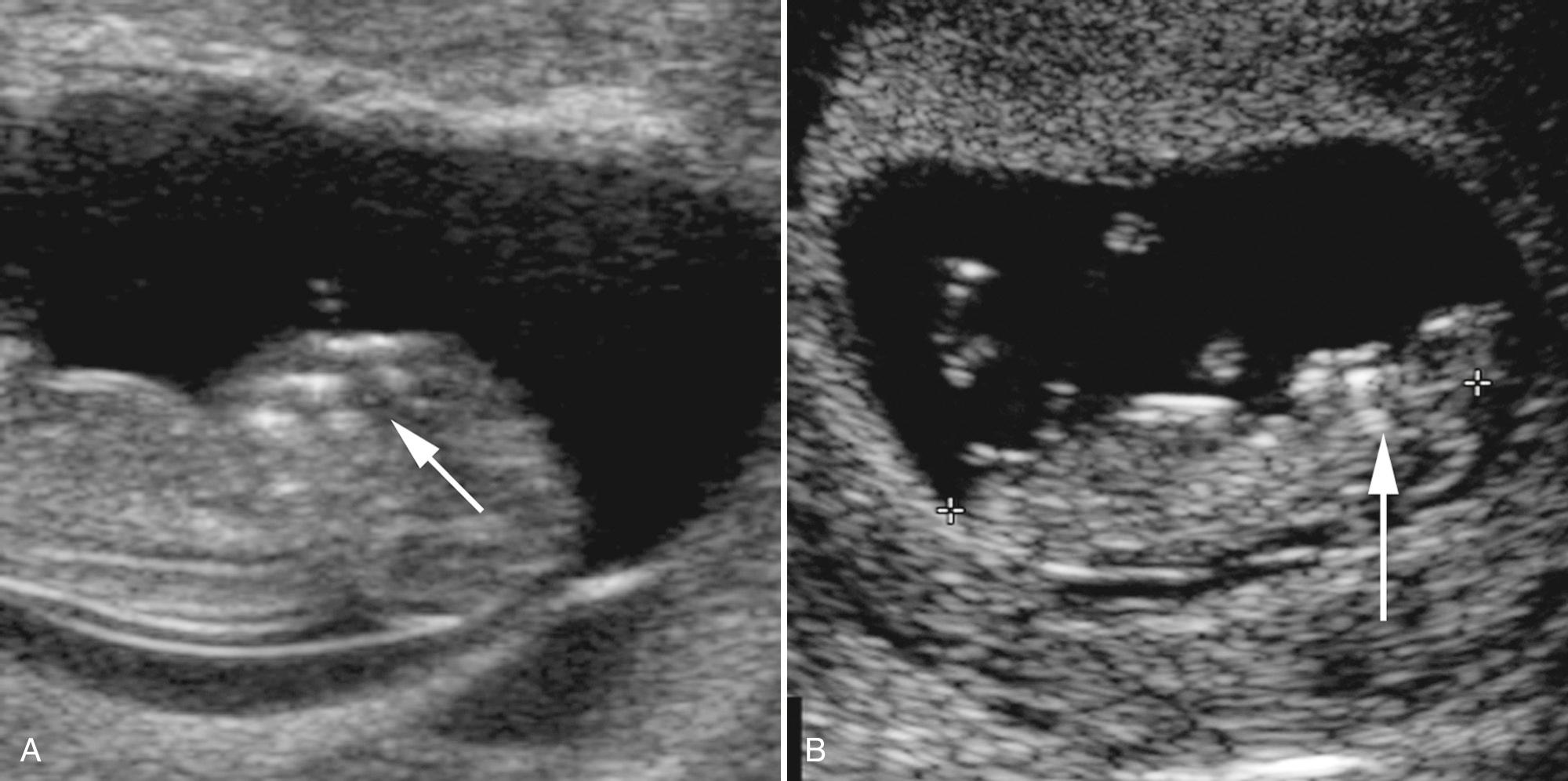
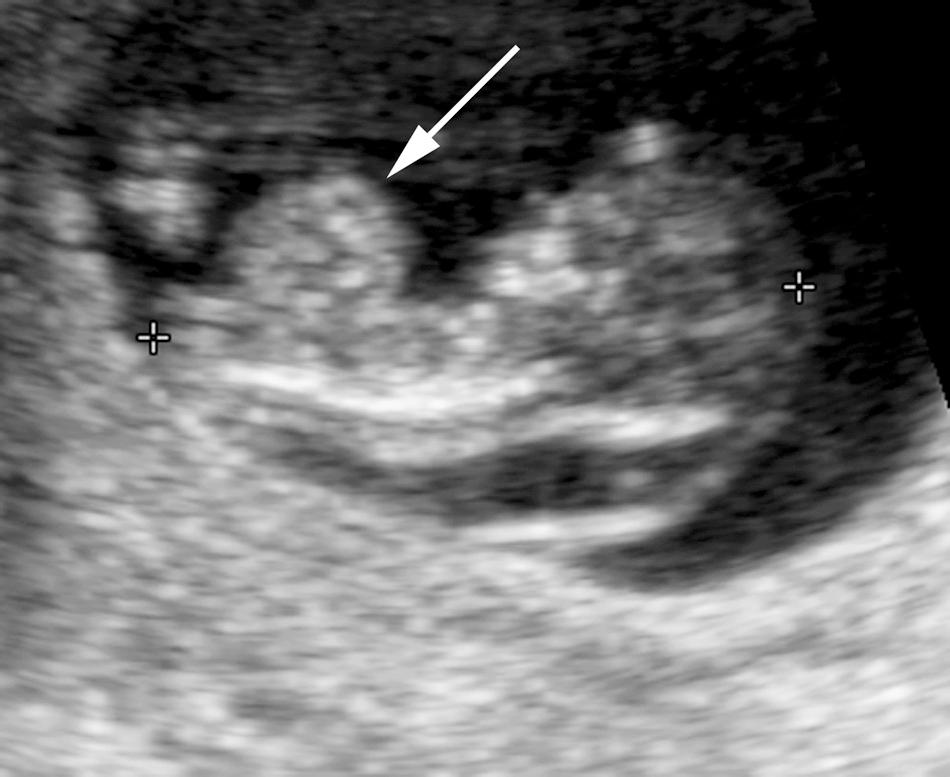
The current ACR/AIUM guidelines for the performance of the second- and third-trimester obstetric ultrasound examinations describe the standard sonographic examination. It is important to understand that the guidelines were written to maximize detection of many fetal abnormalities but are not expected to allow for detection of all structural abnormalities.
The terminology level I and level II examinations refer to “standard” or “routine” (level I) and “high risk,” “specialized,” or “detailed” (level II) obstetric ultrasound. The concept of these two levels of scanning is that the standard, basic, routine, or level I examination is performed routinely on pregnant patients ( Figs. 28.7 to 28.15 , Videos 28.3 ) to . The methods to obtain all the required images are described in detail in subsequent chapters. This chapter provides a collage of figures as a guide for the anatomic survey and common additional views obtained during a fetal survey.
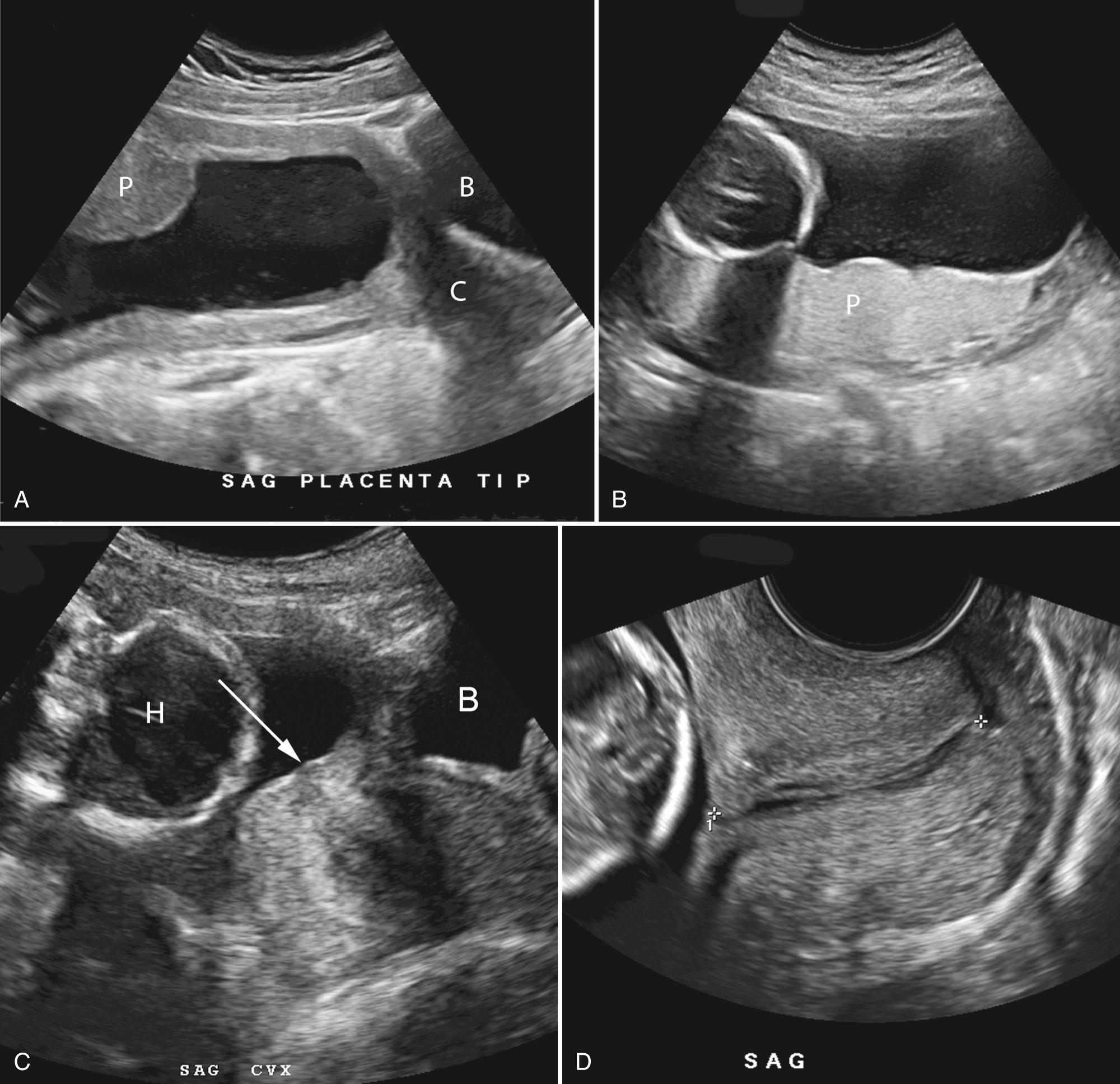

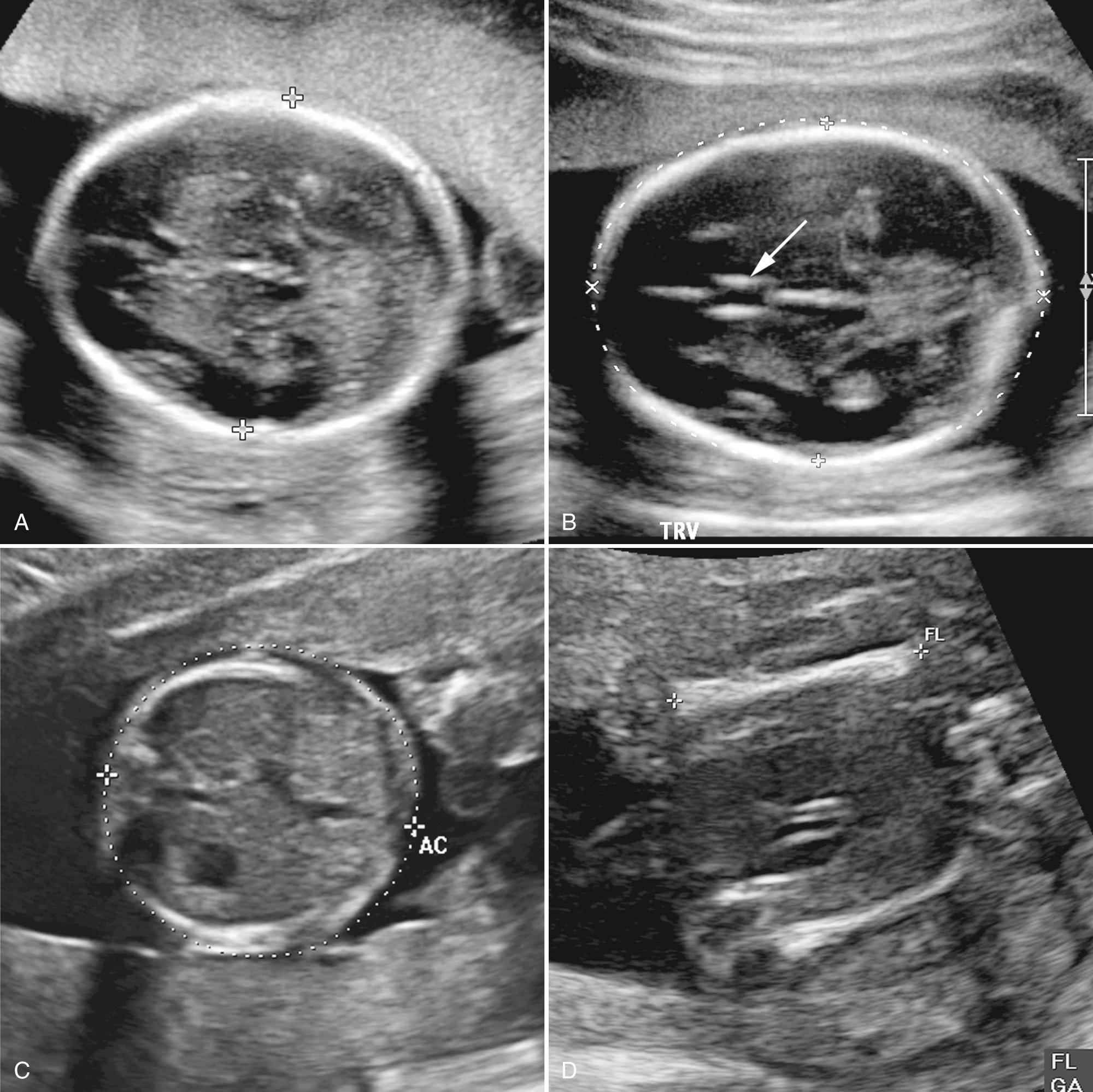
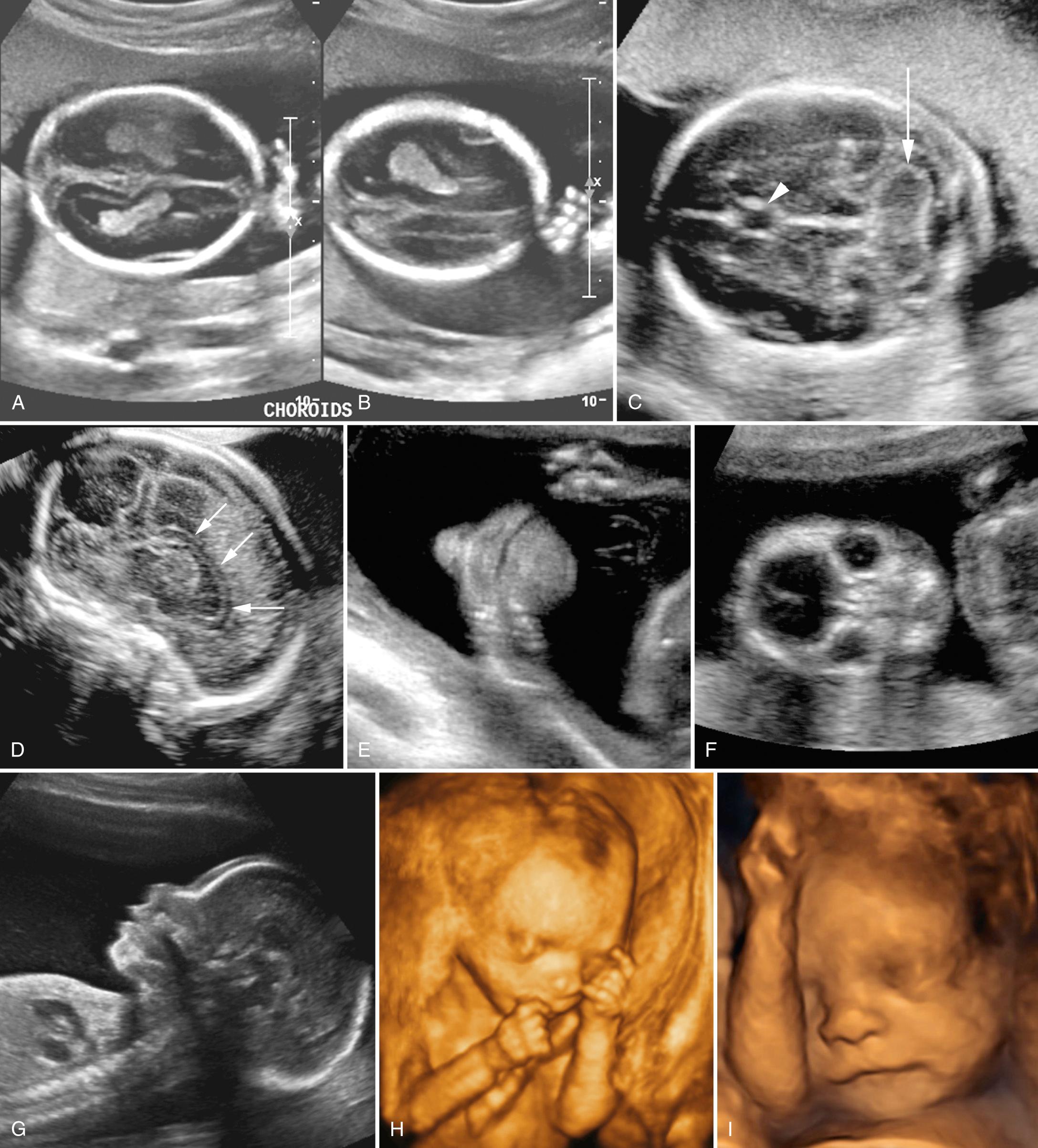
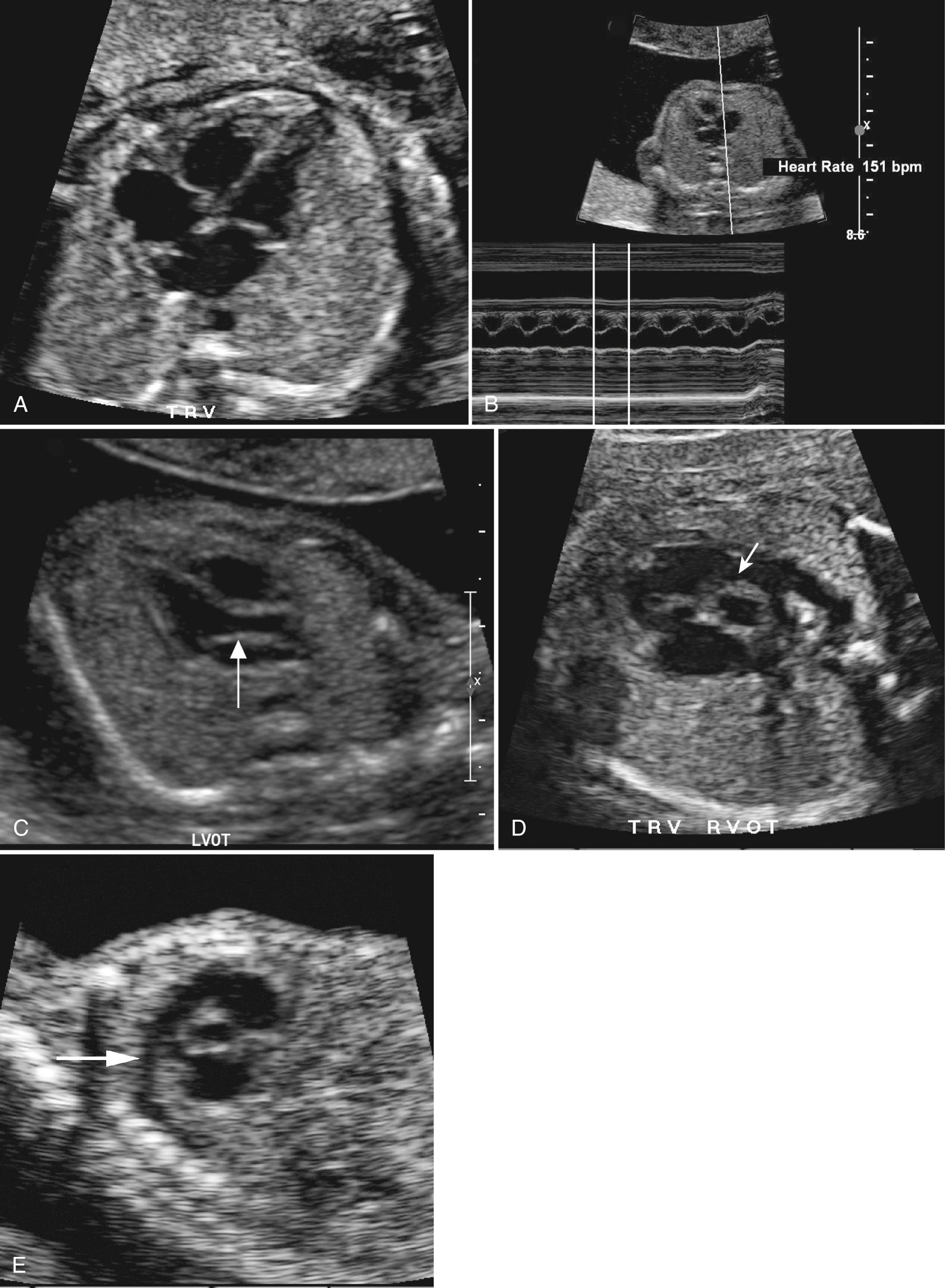
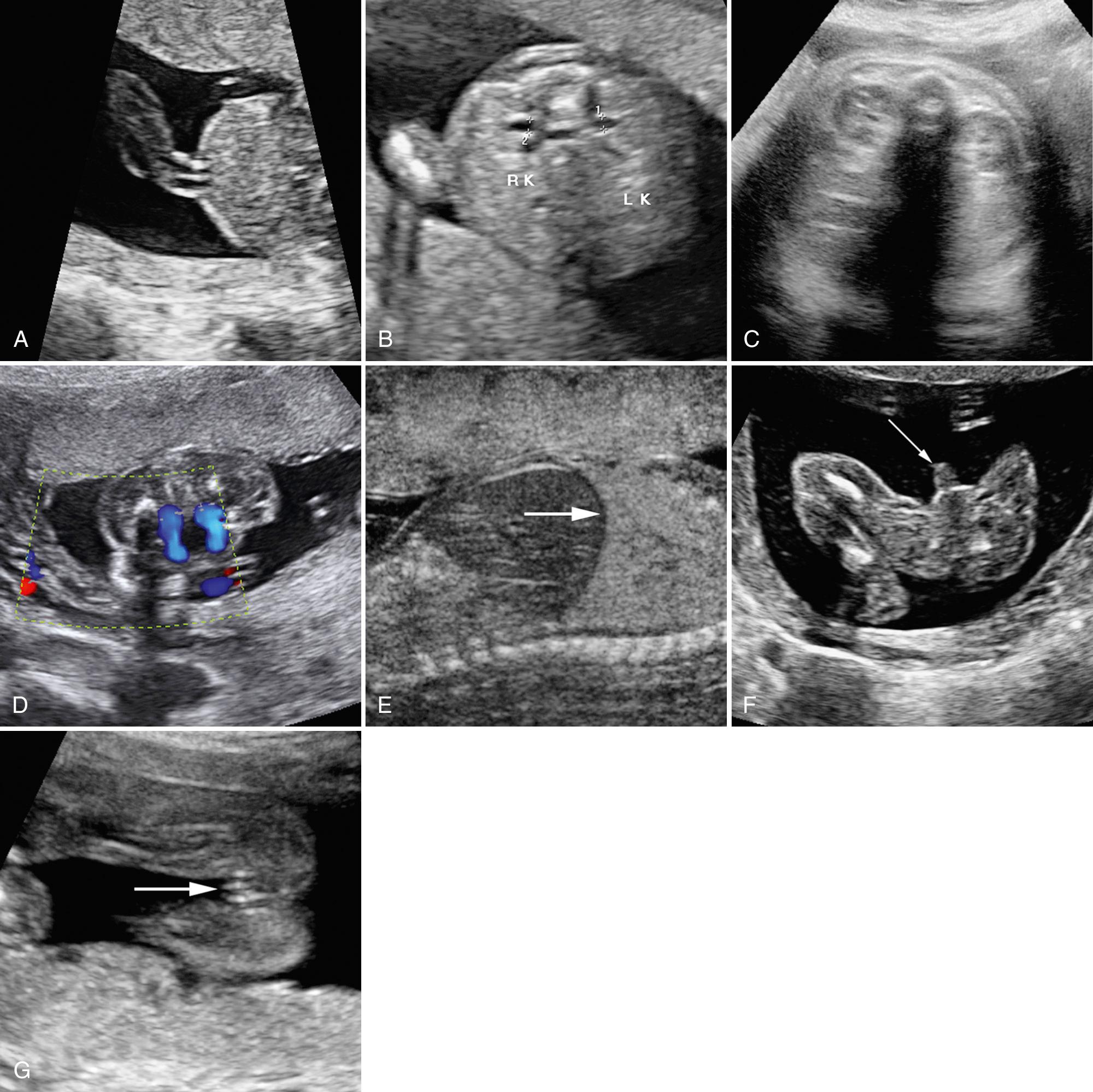
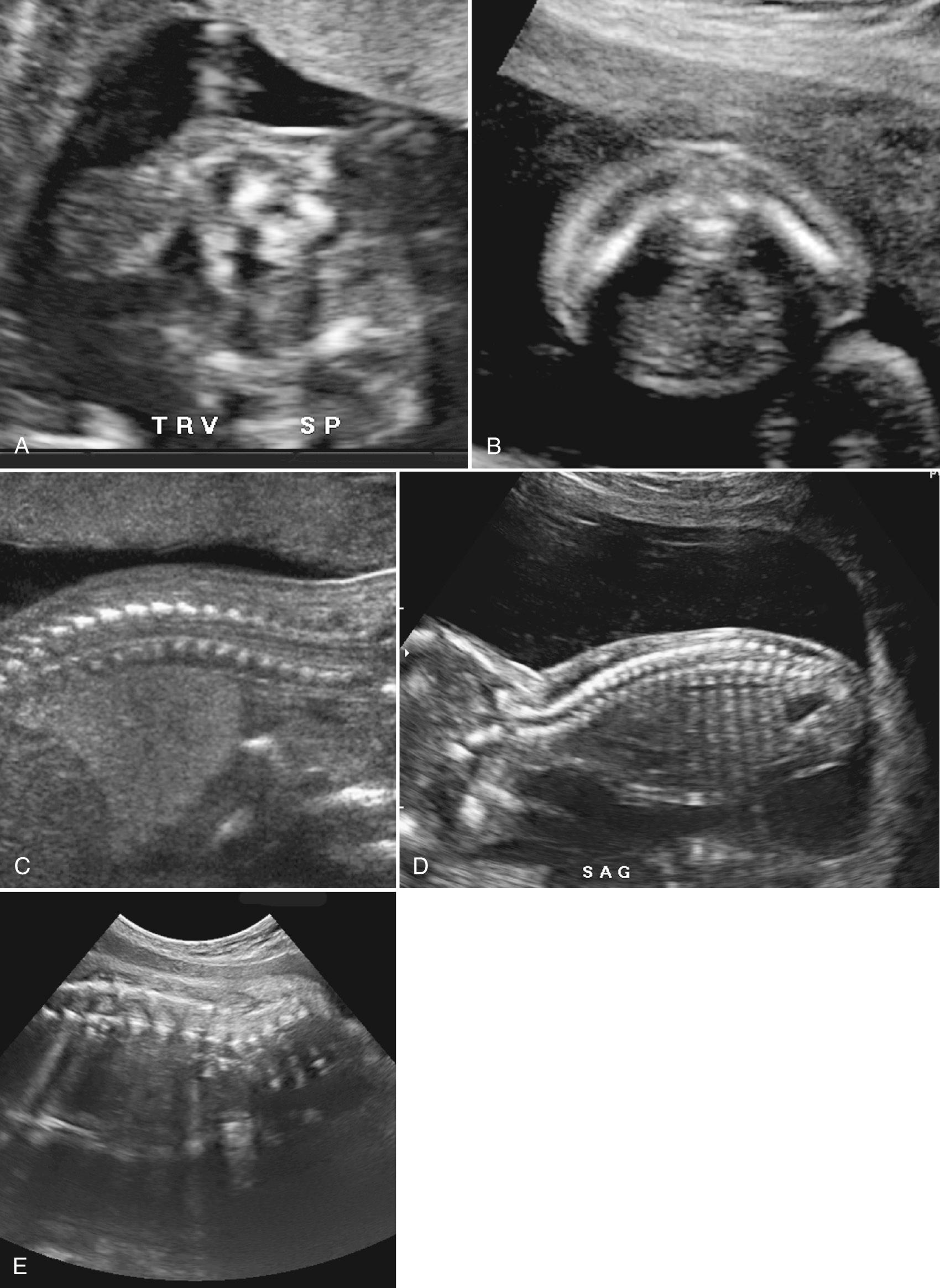
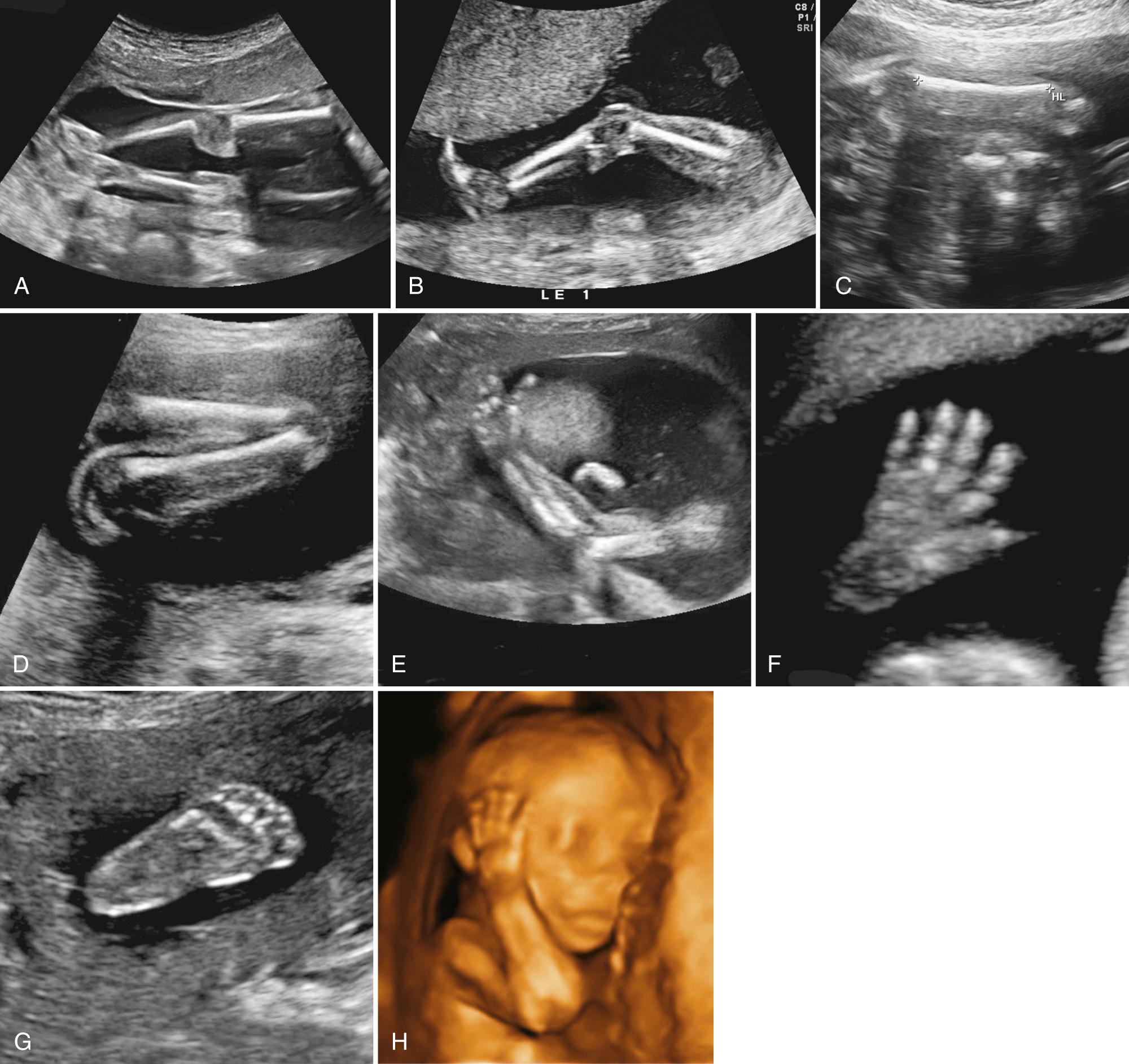
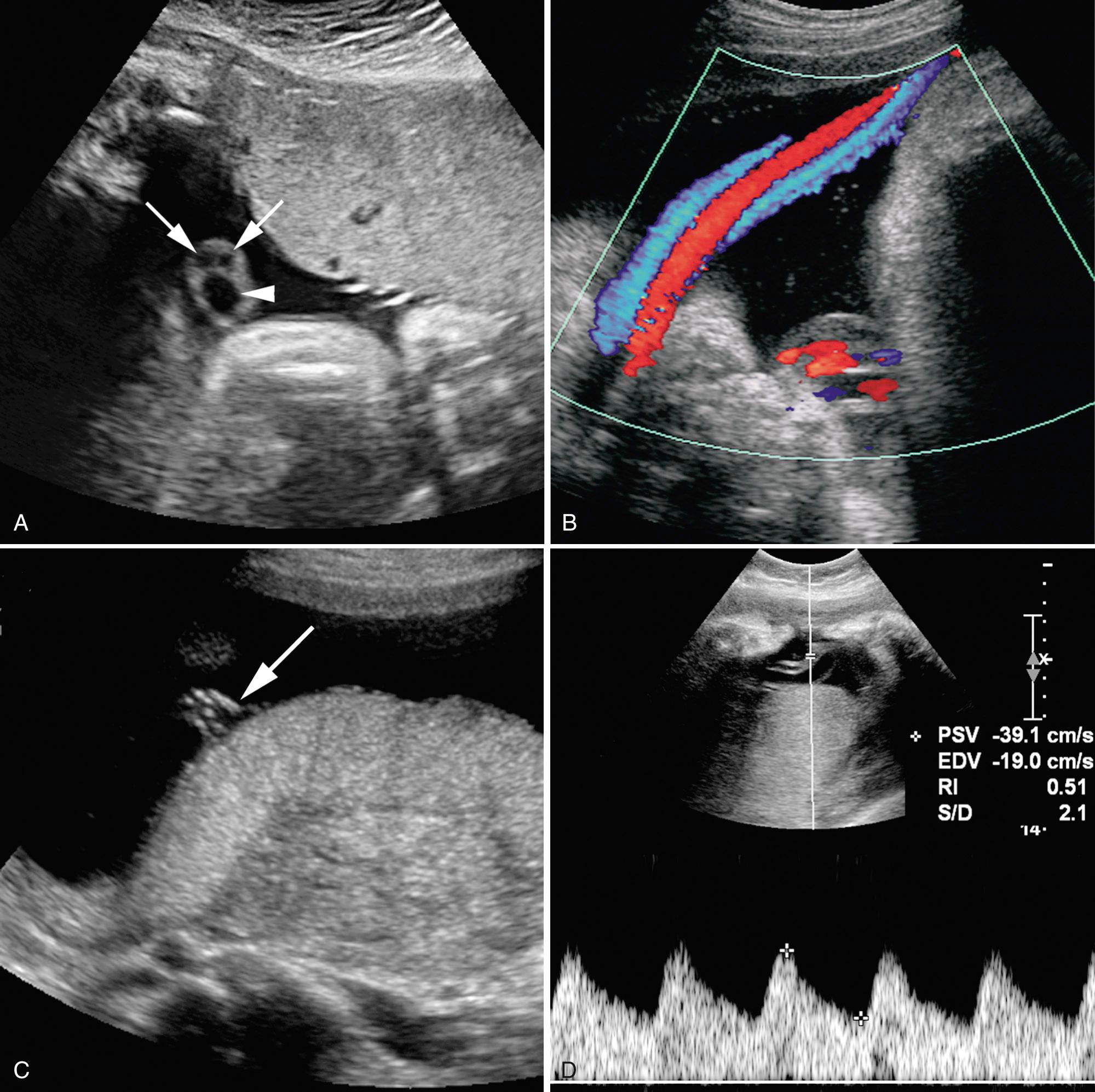
In general, the “standard fetal anatomic survey” refers to the second-trimester scan, typically performed between 16 and 22 weeks of gestation. When anatomic surveys are performed at 20 to 22 weeks' gestational age, there is less need for repeat scans to document normal anatomy compared to studies performed earlier in pregnancy. However, there are practical considerations when determining the optimal timing of studies. In well-dated pregnancies in women who are unlikely to want amniocentesis, a survey at 20 to 22 weeks' gestation is optimal. However, if a pregnancy is not well-dated, an earlier scan may be needed both to establish accurate dates for the pregnancy and to assess the anatomy. Some centers offer the scan at 16 weeks' gestation to coincide with performance of genetic amniocentesis and/or midtrimester quadruple serum screening.
The level I examination consists of investigation of the maternal uterus and ovaries, the cervix, and placenta ( Fig. 28.7 , ), as well as a systematic review of fetal anatomy. Adnexal cysts are common in pregnant women. In early pregnancy a cyst is most likely the corpus luteum. If a cyst appears atypical or enlarges beyond the middle second trimester, it should be further assessed. Leiomyoma position and size should be documented. If the myometrium appears thin in the lower uterine segment (e.g., <3 mm in a woman with prior cesarean section), the myometrium should be measured with transvaginal sonography and should be followed later in pregnancy because the thin myometrium puts the woman at risk for uterine dehiscence and/or rupture. It is helpful to begin the examination with a sagittal midline view to assess the cervix. If the cervix appears abnormally short or if placenta previa is suspected, a vaginal scan can then be performed.
Cardiac activity: document with M-mode
Presentation: cephalic, breech, transverse, variable
Fetal number: for multiples, amnionicity/chorionicity, concordance with size, amniotic fluid
Maternal anatomy: uterus, adnexa, and cervix
Gestational age and fetal weight assessment
Biparietal diameter
Head circumference
Abdominal circumference
Femur length
Amniotic fluid
Estimate as normal
If abnormal, quantify if high or low
Placenta: position
Become a Clinical Tree membership for Full access and enjoy Unlimited articles
If you are a member. Log in here